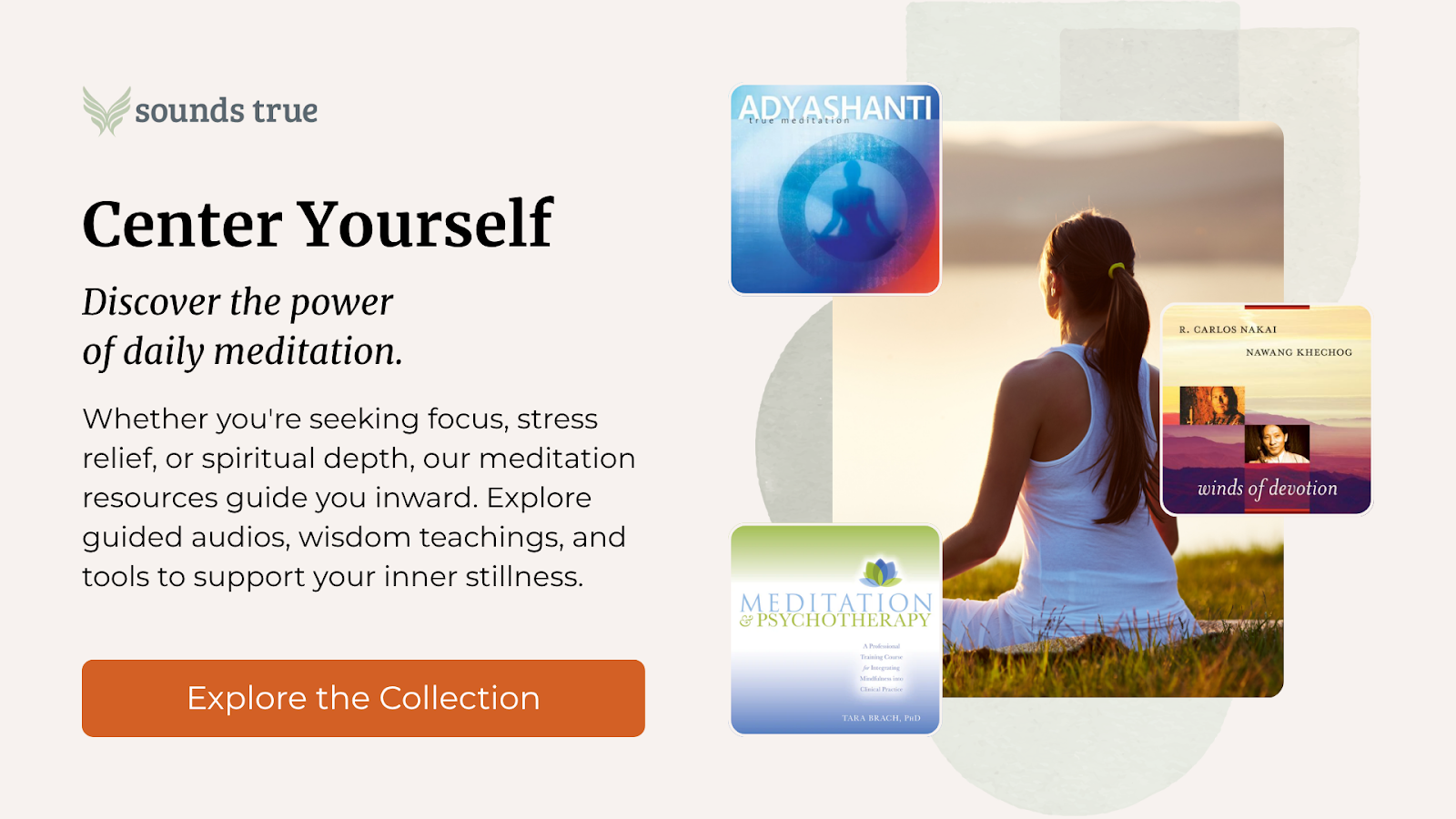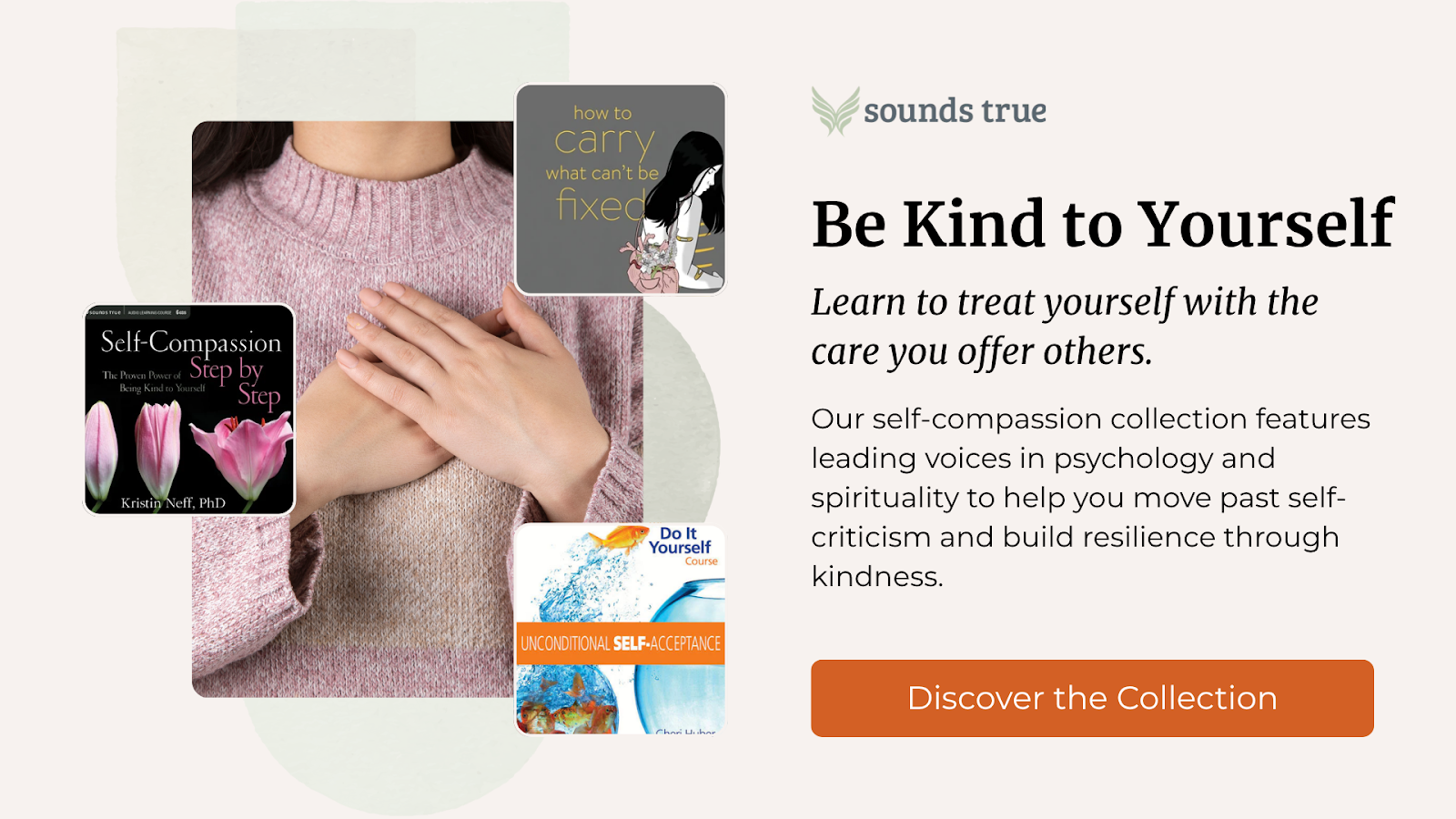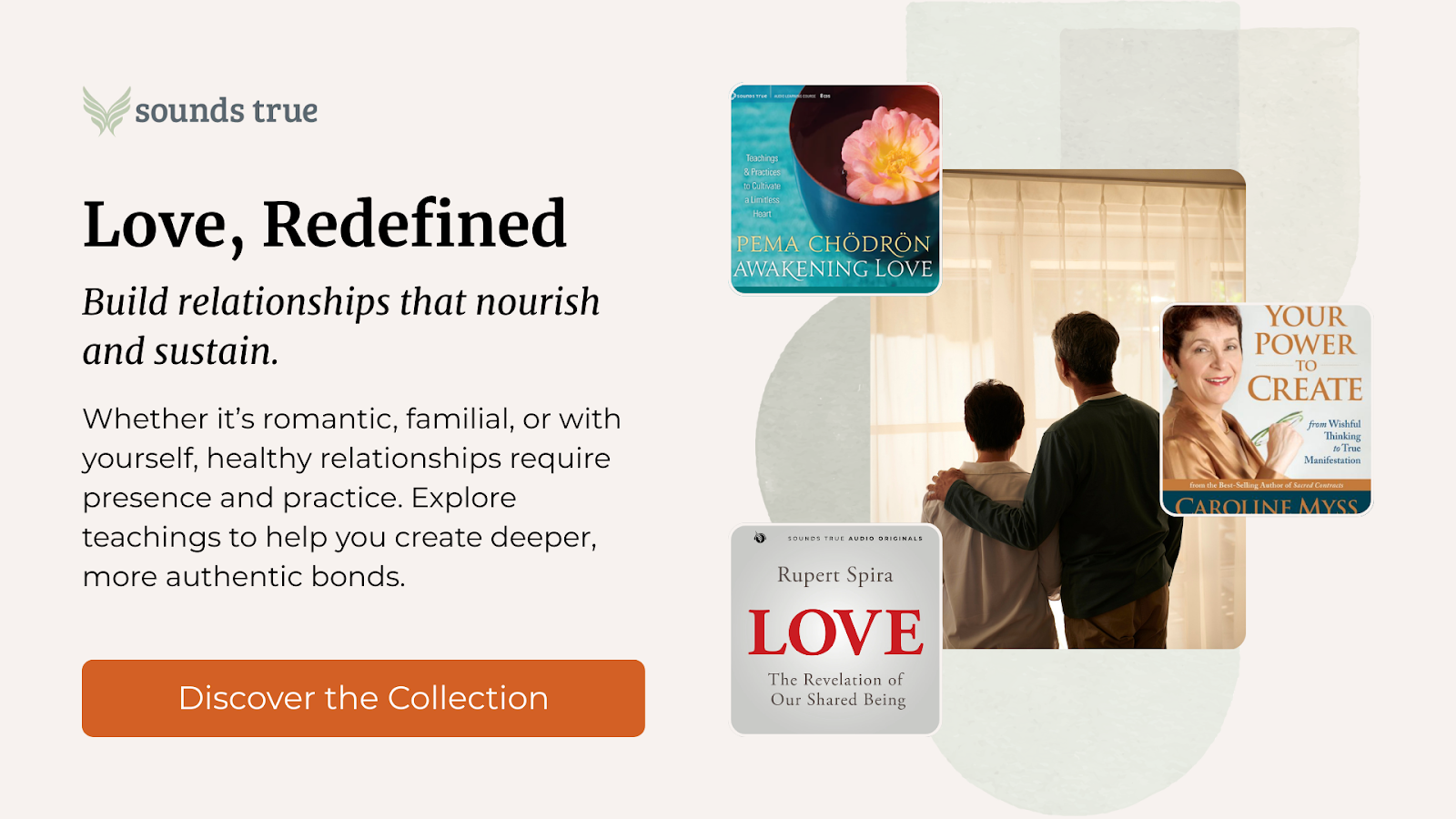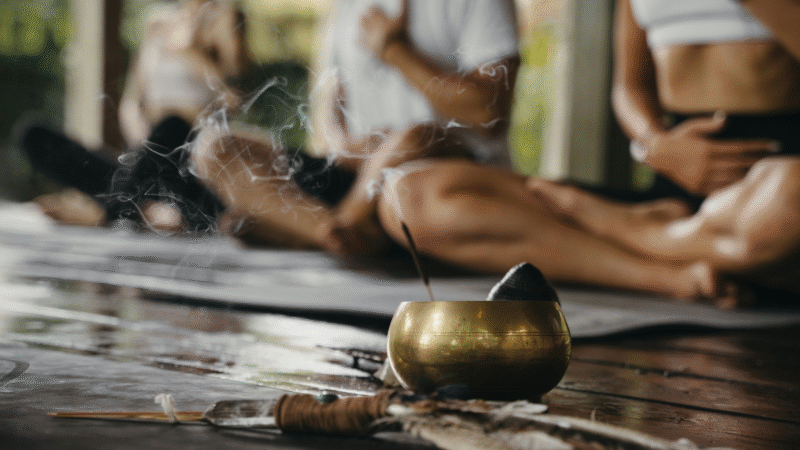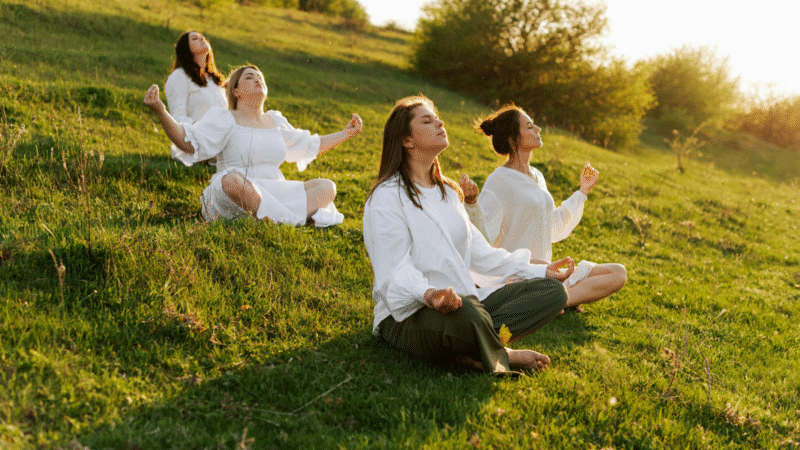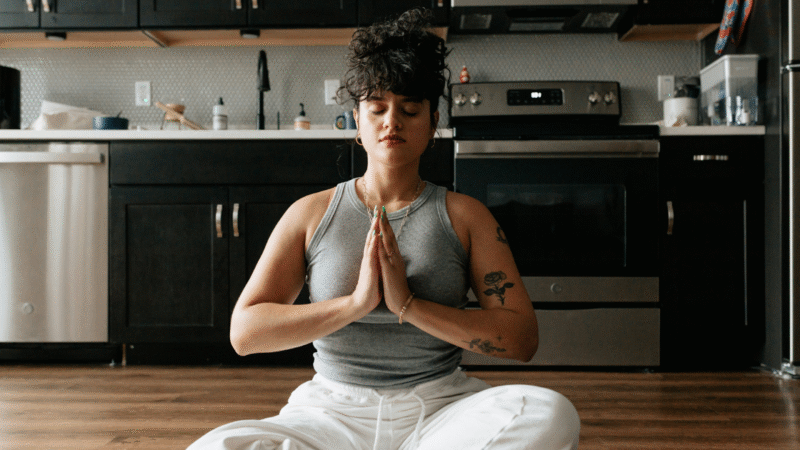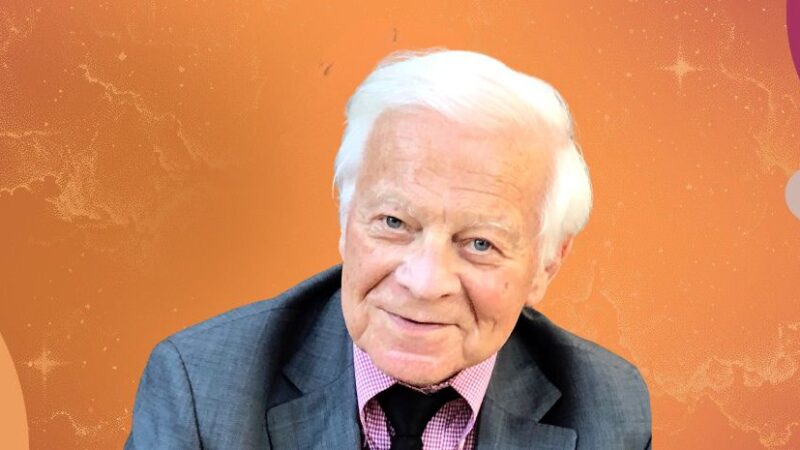The search for peace can feel elusive in a world filled with endless notifications and constant noise. At Sounds True, we honor this longing to slow down and reconnect. You may have asked what is a guided meditation session is in conversation or during your favorite podcast. Now you might wonder what this practice can offer you right now.
Guided meditation invites us into a safe harbor, anchored in the wisdom of those who’ve walked this path before us. It serves as a trusted voice lighting the trail through the mind’s wild brambles. Whether you are a seasoned spiritual seeker or someone exploring meditation for the first time, this practice meets you exactly as you are.
At Sounds True, our community is built on heart-led communication, respect, and the belief that every person carries the capacity for growth, healing, and presence. In the sections ahead, we’ll walk you through what a guided meditation session is, how it can be woven into your life, and why so many turn to it when the inner world feels anything but calm.
Key Takeaways:
- How Guided Meditation Differs from Silent Practice: Guided meditation offers companionship on the inward path. Instead of journeying through silence alone, you’re gently led by a teacher’s voice that helps you stay centered when the mind begins to wander.
- Core Benefits of Guided Meditation: Guided meditation invites calm into the body and mind through steady, compassionate awareness. Regular practice can ease daily tension, foster emotional steadiness, and awaken self-kindness. For many, these sessions also improve sleep quality and strengthen mindful presence.
- Choosing a Guide and Prepping for Your First Session: The right guide begins with resonance. Explore teachers, tones, and traditions that create a feeling of trust and ease. Before you begin, prepare your space with care: soften the lighting, settle into a comfortable posture, and approach the session openly.
How Guided Meditation Differs from Silent Practice
At its essence, guided meditation offers a shared journey into presence. Instead of sitting in silence with only your breath, you’re gently led by a teacher’s voice or someone who helps you return to awareness. Through words, imagery, and pauses, the guide becomes a companion, shaping a sense of rhythm and focus that many beginners find reassuring.
Silent Practice: Learning to Listen Within
In silent or self-directed meditation, there’s no external guide, only your breath, your body, and the soft stirrings of your inner landscape. You choose an anchor, such as your breath or a simple phrase, and return to it each time the mind begins to wander. This approach can be deeply freeing, though it may feel daunting for beginners who crave direction.
Silent meditation builds inner steadiness and patience over time. As you sit quietly, distractions arise and dissolve. You learn to observe your thoughts without clinging or resistance, developing trust in your own ability to return to stillness.
Guided Meditation: A Supported Path to Presence
In contrast, guided meditation brings another voice into the experience. A teacher may encourage you to notice your breath, relax each part of your body, or visualize a peaceful landscape. The practice offers grounding for those new to meditation or anyone seeking ease during emotional or stressful times.
Through this guidance, beginners often find it easier to remain focused. The steady rhythm of words keeps the mind from wandering too far, while the imagery nurtures connection, compassion, and calm. For some, guided meditation becomes a bridge into deeper self-directed practice; for others, it remains a beloved lifelong approach.
Exploring the Many Types of Guided Meditation
There are countless ways to experience guided meditation, each offering a unique flavor of mindfulness:
- Mindfulness Meditations: These practices invite awareness of breath, body, and sensations in the present moment.
- Loving-Kindness Meditations: Also known as metta practice, these sessions focus on cultivating warmth and compassion toward yourself and others.
- Visualization Meditations: Here, the guide may lead you through peaceful imagery or symbolic journeys that calm the nervous system and center attention.
- Movement and Sound Practices: Some meditations incorporate rhythm or gentle movement. You can explore practices like inner rhythm meditations, which use sound and flow to synchronize body and mind.
Open-Eye Meditations: For those who prefer to stay visually connected to the world, Open eye meditation offers another entry point, one that blends awareness with everyday life.
Core Benefits: From Calmer Nerves to Deeper Self-Compassion
Guided meditation is more than just a soothing voice or a peaceful background track. At its core, this practice offers a gentle invitation to slow down and reconnect with your body, your breath, and the deeper currents of your life. Let’s highlight the core benefits tied to guided meditation sessions.
Easing Everyday Stress
Life can often feel like a rush of unfinished to-do lists and unanswered messages. Guided meditation grants you a chance to step away from mental clutter. Studies consistently find that even brief, regular sessions help dial down the nervous system’s stress response, inviting a sense of calm that lingers well beyond the meditation itself. Over time, this simple practice becomes a way to meet stress with greater steadiness.
Enhancing Emotional Balance
Guided meditations often gently encourage us to notice and welcome our feelings without judgment or urgency to “fix” them. This practice nurtures emotional flexibility, and as the mind quiets, you begin to see emotions as waves passing through rather than storms to resist. Gradually, you develop the inner capacity to greet sadness, frustration, and joy with equal presence and curiosity.
Cultivating Self-Compassion
At their best, guided meditations help us turn inward with kindness. Unlike silent meditation, where we may be left alone with our thoughts, a skillful guide provides supportive language that fosters self-acceptance. This kind of inward listening can be transformative for those learning to treat themselves with the same tenderness they offer others.
Support for Restful Sleep
Many people find that guided meditation becomes a nightly ritual or a handrail into rest. Through calming imagery and body awareness, the practice quiets the mind and signals the body to unwind. These sessions can help restore natural sleep rhythms, leaving you more refreshed and balanced upon waking.
Deepening Mindful Presence
Finally, guided meditation invites us into the here and now—not as something to perfect, but as a welcome homecoming. With practiced attention, we learn to notice the textures of a moment: the sensation of breath, the support of the earth beneath, the simple miracle of being alive. These small moments of presence have a way of quietly expanding, coloring even the busiest days with greater awareness and peace.
Choosing a Guide: Voices, Styles, and Traditions
Exploring guided meditation often begins with finding a voice that feels like home. The right teacher can shift a simple session into something luminous, like an experience that feels personal, human, and alive. Every guide brings their own rhythm and way of seeing the world, creating a path that meets you where you are.
The Power of Voice
A teacher’s voice shapes the atmosphere of your practice. A gentle tone might feel like being wrapped in soft light, steady and soothing. A grounded, clear delivery can awaken focus that helps guide you when the mind begins to wander. Each voice carries a unique vibration that communicates presence long before the words themselves do. As you explore, take time to listen to different guides. Notice which voices stir ease or trust within you. When that resonance appears, you’ve found a companion for your inward journey.
A Spectrum of Styles
Guided meditations come in countless flavors. One guide may center the breath, inviting stillness and observation, while another might weave creative visualization or gentle body awareness, opening a space where imagination and calm can coexist. The diversity of approach means there is always a doorway waiting for you to step through.
Curiosity is your best ally. Therefore, let your instincts lead as you discover what feels nourishing. If grounding focus appeals, test the waters with open eye meditation to cultivate mindfulness while staying visually connected to the world. If rhythm and movement speak to you, inner rhythm meditations offer a way to feel presence through sound and gentle motion.
Rooted in Diverse Traditions
Many guided meditations are infused with wisdom from spiritual and contemplative traditions: Buddhism, yoga, secular mindfulness, mysticism, and beyond. Some teachers honor the roots of these teachings, weaving in stories, chants, or rituals passed down through generations. Others translate ancient insights into modern, accessible language, focusing on the universal truths of presence and compassion. You might notice how the traditions you choose shape the mood and message of your practice, inviting you to learn not just how to meditate, but also to participate in a lineage of healing and awakening.
In the end, your guide and the tradition they carry can become a companion: someone to walk beside you as you explore the quiet depths within. Allow yourself patience and openness as you experiment. The right guide is out there, ready to meet you with understanding and kindness.
Preparing for Your First Session: Space, Posture, Mindset
Stepping into your first guided meditation can feel like opening a door you didn’t know existed. Setting yourself up begins with the tone you create, both around you and within.
- Create a space that feels safe and steady: Choose an area that invites ease, such as a favorite chair, a cozy corner near sunlight, or a soft rug beneath your feet. Add small details that ground you: a candle’s glow, a favorite stone, or a scent that calms the senses.
- Set the mood for inward focus: Begin by dimming harsh lights and silencing distractions. A warm blanket, gentle instrumental music, or the sound of rain can help you ease into awareness.
- Find your posture of ease: Rest where your body feels supported, whether cross-legged on a cushion or seated in a sturdy chair. Let your spine lengthen like a gentle line of light while your shoulders drop away from tension. Rest your hands on your lap or knees, palms open. A posture of balance keeps the body awake and the mind relaxed.
- Invite your breath to guide you: Take a slow inhale and let the air move through you without effort. Feel the quiet rhythm of each breath—steady, natural, unforced. This simple attention bridges your awareness between body and mind, helping you settle into presence before the session begins.
- Bring a mindset of curiosity and kindness: Release expectations of perfection. Thoughts may rise, the body may fidget, or emotions may appear unannounced. Meet them all with patience. Guided meditation is less about control and more about welcoming what arrives with compassion.
Tech, Apps, and Recordings: Finding Resources That Resonate
Accessing guided meditation today has become beautifully simple. Technology can open meaningful pathways to practice, helping you find presence wherever you are. A phone, tablet, or computer becomes a bridge to teachings that steady the mind and invite awareness into daily life.
- Explore meditation apps that meet you where you are: Many apps offer guided sessions designed for both new and experienced practitioners. You can begin with five-minute meditations or explore longer practices that deepen over time. These digital tools often include themes such as stress relief, rest, and gratitude, allowing you to discover a rhythm that feels natural.
- Listen through streaming platforms and downloads: Online libraries hold vast collections of meditations. As you listen, notice which voices awaken calm or clarity within you. At Sounds True, you’ll find a living library of resources, from audiobooks and digital courses to free readings and guided practices.
- Integrate practice through wearables and smart speakers: A soft chime from your smartwatch or a voice-activated session in your living space can turn any pause into a moment of grounding. These tools weave mindfulness into ordinary routines, reminding you that meditation need not be confined to a quiet room.
Final Thoughts
At its heart, guided meditation is an invitation to slow down, listen inwardly, and rediscover the peace that has always lived within. For those exploring what is a guided meditation session, this practice offers a gentle companion on the path toward mindfulness and presence. Whether you are new to meditation or deepening an existing practice, each session opens a doorway to greater clarity and compassion.
Through the voices of trusted teachers, ancient wisdom meets the moment you’re in now. Every breath, every pause, becomes part of a lineage of awareness that has been carried across generations and continues through your own experience. Beginning doesn’t require perfection; only a willingness to sit, breathe, and notice what arises. From all of us at Sounds True, may your practice be steady, forgiving, and rooted in kindness.
Read More:
- From Stress Relief to Inner Growth: Exploring the Benefits of Meditation
- Mindfulness vs. Meditation: How Each Practice Transforms Your Mental Health
- Honey Tasting Meditation: Build Your Relationship with Sweetness
Frequently Asked Questions About Guided Meditation
How long should a beginner practice guided meditation?
As you step onto this new path, even five to ten minutes a day can be just right. This isn’t a race as guided meditation is about meeting yourself where you are. Over time, as sitting with your own stillness becomes more comfortable, you might feel drawn to gently extend your practice. There’s no “perfect” length; what matters is consistency and kindness toward yourself.
Can guided meditation help with stress?
Absolutely. Guided meditation offers a compassionate handhold through stress, inviting your awareness to soften, helping you reconnect with your breath, your body, and the present moment. Regular practice can help ease tension, lower your stress response, and offer a more balanced perspective on everyday challenges.
Can guided meditation help with anxiety or depression?
For many, guided meditation is a steady anchor amid turbulent emotional waters. While it’s not a replacement for professional support, meditation can nurture a gentle awareness of anxious or low moods. Listening to a caring guide can help you shift out of spirals of worry or self-criticism. If you’re living with anxiety or depression, guided meditation may be a supportive addition to your self-care toolkit.
What if my mind wanders during guided meditation?
First, know this: everyone’s mind wanders, even the most seasoned meditators. When you notice your thoughts drifting, gently bring your attention back to the guidance. Each time you return is a moment of mindfulness, a tiny act of self-kindness. This is truly where the practice begins.
Is guided meditation religious or spiritual?
Guided meditation, at its core, is simply a way of bringing mindful awareness to your inner world. While rooted in many rich spiritual traditions, today’s guided meditations are welcoming to individuals of all beliefs, or none at all. You’re invited to bring your own experience, values, and sense of meaning to the practice.
How often should I do guided meditation?
As often as feels nourishing! Some folks find grounding in a daily practice, while others weave guided meditation into weekly routines. The key is to listen to what your body, heart, and spirit need. Let each session be another opportunity to meet yourself with gentle presence and curiosity.

Michelle Cassandra Johnson is an author, activist, spiritual teacher, racial equity consultant, and intuitive healer. She is the author of six books, including Skill in Action and Finding Refuge. Amy Burtaine is a leadership coach and racial equity trainer. With Robin DiAngelo, she is the coauthor of The Facilitator's Guide for White Affinity Groups. For more, visit https://www.michellecjohnson.com/wisdom-of-the-hive.
